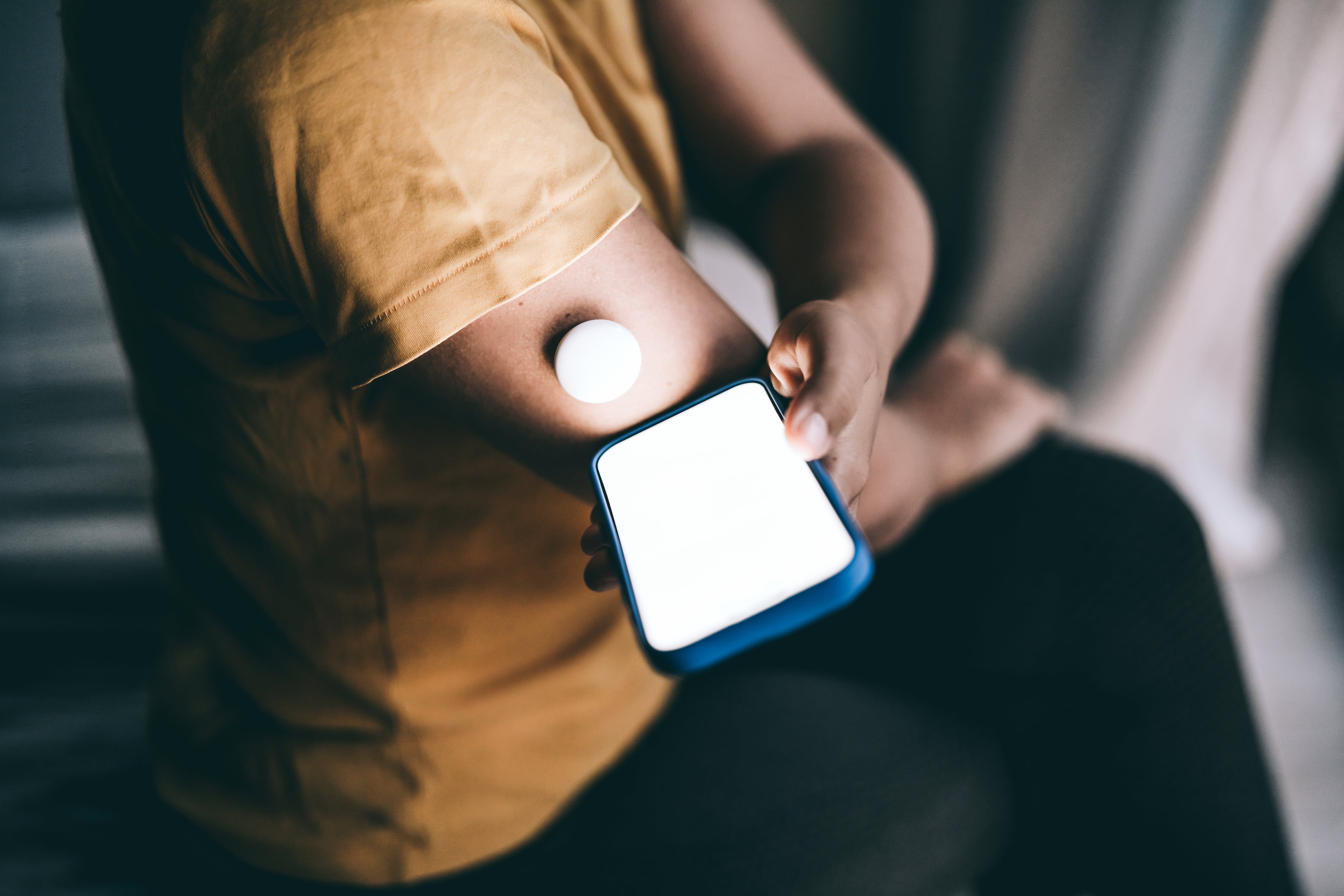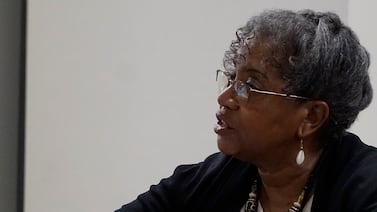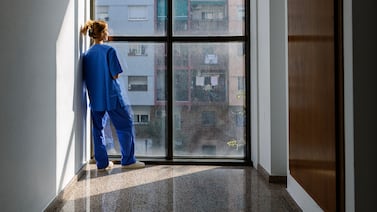Public health, explained: Sign up to receive Healthbeat’s free New York City newsletter here.
Albert Edwards, 61, has been living with Type 2 diabetes for over 24 years. When he was first diagnosed, he did not take it seriously. He was not taking his prescribed medication, and he continued to eat and drink items with a lot of sugar.
Edwards said it got to the point where his highest A1C, which measures the amount of sugar in a person’s blood, was 14.4%. The average A1C for a non-diabetic should be less than 5.7%. A higher A1C level increases the risk of complications from diabetes.
His diabetes is now under control, but Edwards has dealt with a few symptoms from when it wasn’t: blurred vision and diabetic neuropathy, which is nerve damage that causes pain in his feet.
“I wish I would’ve [taken] care of it sooner,” Edwards said. “I could have reversed it.”
In addition to eye and nerve damage, the long-term effects of high blood sugar from diabetes can include hearing loss, a higher risk for amputations, slow-healing wounds, cavities and gum disease, heart attack or heart failure, sexual dysfunction, chronic kidney disease, and stroke or memory loss.
Chronic diseases like diabetes disproportionately affect communities of color and those with low incomes. According to New York City’s Health Department, in 2022, heart disease and diabetes were among the leading causes of death among the Black, Hispanic, and Asian and Pacific Islander communities. This problem is further exacerbated by systemic inequities that create disparities in wealth, and access to food, resources, and health care.
To address the challenge, the Health Department’s Bureau of Brooklyn Neighborhood Health is partnering with long-standing community organizations to establish a network of Diabetes Self-Management Education and Support classes approved by the Centers for Disease Control and Prevention. The classes have been shown to help people keep their diabetes under control and decrease their risk of complications.
These support classes are integral in improving the health of people of color in Brooklyn because they are tailored to their specific needs. They provide a space to share and learn about living with diabetes for people who may not have access to primary care.
“Some people have been diagnosed over 10 years ago, and they’ve never been provided a referral for a diabetes specialist or nutritionist, which is really disheartening to hear because a lot of people have even been told to just Google it,” said Tanisha Herrera-Pearce, program manager at the city’s Health Department.
People with diabetes need the space to talk about it, share the frustrations they have, and figure out how to live with the disease within the constraints of their lives, she said.
HealthyNYC aims to reduce deaths related to diabetes
The ability to connect with fellow diabetics is an enticing factor to those who are looking to foster a sense of community. Twenty-eight-year-old Angelica Caballero has been living with Type 1 diabetes for 18 years. She has recently begun to look for an education class or peer support group because she doesn’t know any other diabetic people.
Caballero said that although she could probably find groups online, “there should be more in-person groups where people can come together and talk and hang out” close to her Brooklyn home. “At the end of the day,” she says, “as much as your family supports you ... they don’t really understand what you go through.”
In 2023, Mayor Eric Adams’ administration and the NYC Health Department launched HealthyNYC. The campaign aims to reduce the number of deaths related to heart disease and diabetes by 5% by 2030.
As part of this initiative, the Bureau of Brooklyn Neighborhood Health is working to expand the DSMES services being offered in Bedford-Stuyvesant and Bushwick. Both neighborhoods are home to populations that are predominantly Black or Hispanic.
These areas have higher rates than the city average of adults with poor glycemic control and diabetes diagnoses. They also have higher rates of premature death – defined as before age 65 – due to diabetes.
Herrera-Pearce said those neighborhoods have been underserved compared to areas like Park Slope. In 2022, the premature death rate in Park Slope was 136.8 per 100,000 people, compared to 186.6 in Bushwick and 303.9 in Bed-Stuy.
Five weeks of classes cover nutrition, exercise, blood sugar monitoring
Although the classes are not new, they were recently reimplemented by the Health Department with the launch of HealthyNYC. After the Covid-19 pandemic, many of the community-based partners had stopped offering the classes. Since 2023, the Health Department has hosted at least 25 classes at facilities across Bed-Stuy and Bushwick.
The classes take place over the course of five weeks. Participants are taught about healthy eating and nutrition, how to measure their blood sugar, and ways they can engage in physical activity.
The classes can improve the health literacy in a community and change how people live with diabetes. Many participants have questions pertaining to their medications and how to read nutrition labels. Some people also have lifestyle questions, such as whether they can be physically active, or whether they can travel through airport security with their diabetes medications and devices.
“It’s important to go to those because you learn,” Edwards said. “At first I didn’t go to any, and I was unaware of how serious [diabetes] was.”
Edwards said that in the past, he was able to attend a few group meetings through his doctor. Although he could not make it to all of them, he said the information helped him to improve his eating habits.
DSMES classes are especially beneficial for those who don’t have easy access to doctors. Participants can spend 10 hours with a dietician without having to worry about health insurance.
Class materials tailored to meet needs of Caribbean immigrants
By partnering with organizations like the Bedford Health Center or Riseboro Community Partnership in Brooklyn, the classes can be adjusted to fit the specific needs of the community.
Margrethe Horlyck-Romanovsky is an assistant professor in the Department of Health and Nutrition Sciences at Brooklyn College. In 2023, she, a colleague at Hunter College, and student researchers piloted the CDC’s Diabetes Prevention Program at the Brooklyn College Immigrant Health Lab. She explained that the CDC’s program materials are made for the mainstream American.
“It’s focused on the American experience, which does not resonate necessarily with many immigrant communities and many cultural minorities,” Horlyck-Romanovsky said.
Her team changed some of the program materials to be more relevant to Black Caribbean people who live in New York. The team changed the names of all the characters in the stories, for example, to names that Caribbean New Yorkers would be more likely to identify with. They changed all the photographs to settings that looked like New York City and to people who looked like them.
The program was led by students, diabetes educators, and an advisory board of people of Caribbean descent “who understand the cultural norms, the food, and the many sensitive factors that may contribute to the higher diabetes rates,” she said.
Participants came out of the 16-week virtual program with knowledge and resources that catered to their cultural backgrounds. Aside from information on dieting and exercising, the program helped participants understand the nutritional value of foods that were important to them. Horlyck-Romanovsky said they expressed their appreciation for having health care professionals who explained how they could still enjoy foods like roti, a popular flatbread dish in the Caribbean that can contain high levels of carbohydrates.
The classes offered by the Health Department are also offered in Spanish.
Over the next two decades, Herrera-Pearce said the Health Department hopes that everyone in the most impacted neighborhoods will know that these classes exist, where to find them, and how they can benefit not only people with diabetes, but also people with pre-diabetes and caregivers to people with diabetes. (To find a class, visit the websites of the Bedford Health Center or the Bushwick Health Center.)
Due to Edwards’ experiences dealing with blurred vision and diabetic nerve pain, he said he wouldn’t wish the effects of diabetes on anyone, imploring people with the disease to take care of it.
“It’s not a death sentence,” he said. “It’s just that you have to change your habits. Like they say, diabetes, especially Type 2, is reversible if you eat right, diet, and exercise.”
This story was produced in partnership with the Health & Science Reporting Program at the Craig Newmark Graduate School of Journalism at CUNY.







